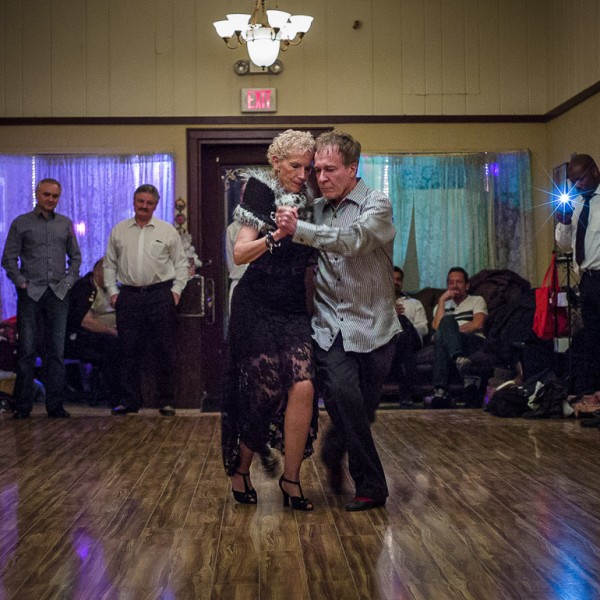First, dancers do not wait for you to take a picture.
Second, they almost never turn both faces to you at the same time, and when they do, they tend to cover them with their arms.
But most of all, it is dark in there. Subversive world of Tango exists on a thin border between light and dark, and the easiest way to destroy its magic is to crank light dimmers all the way up.
- No flash. I mean, no flash, forget it, leave it somewhere, do not even bring it with you. Flash will ruin everything. Even without mentioning what it will do to delicate lighting patterns already in place, just imagine being in bed with your loved one, and one of a sudden someone enters a room, turns lights on and starts cleaning up, for instance. How would you feel? This is how dancers would feel under your speedlight.
- No tripod. Naturally, in low light and no flash you might want to stabilize your camera somehow, and the tripod is the first thing to think about. In this instance, however, the most obvious solution is not the best. The tripod will severely limit your mobility, and dancers will have one more thing on which to trip.
- No bumping into dancers. Be aware of your surroundings. Remember that it is all about the dancers, not about you.
Now, the tricks:
First and foremost, before even getting to the trick list… Low light photography with an SLR camera is a losing proposition. Even with the fastest lens, autofocus will be hunting and hunting, and hunting… When it finds something to focus on, most likely it will not be what you wanted to be in focus. However, it is not really going to matter at that point because whatever you will have wanted to take a picture of would be gone by then. This is the reason Leica M is a weapon of choice here. Its viewfinder is always bright and if there is a slightest possibility to see a difference between a single and a double image, you can focus it, especially against the light. Manually focusing an SLR equipped with just a matte screen is impossible in low light, as you have to use small details for focusing, and it is too dark to figure out how sharp they look. Your getting a focusing screen with a split-image rangefinder for your SLR is something that I would personally enjoy watching.
Another advantage of Leica M design is that since there is no mirror, there is no mirror shake. It is especially important on shutter speeds between 1/10 and 1/30 sec. Motion blur can be used to convey speed, but camera shake usually just ruins the shot. With Leica M it is very much possible to successfully handhold it at 1/15 of a second with a 50mm lens.
Now, back to the bag of tricks…
- Forget about B&W. Tango is a dance of passion. Passion is not black and white, it is vivid.
- Use a fast lens. By fast I mean as fast as you can afford. This may sound discouraging for zoom lovers, as there is no zoom lens in existence, which is fast enough.
- Shooting wide open do not get too close, or depth of field will be too shallow to get both dancers in focus. That is, of course, if you want both dancers in focus.
- Shoot from below. DO NOT shoot from above dancers’ eye level, or you will end up with huge heads and short legs. Using the low vantage point, however, will do the opposite: legs will look longer making poses more elegant.
- Shooting from below keep both eyes open. If you don’t, somebody will inevitably step on you. The best pictures usually come out from normal, or moderately wide lenses, hence a need to get right in there. Dancers often keep their eyes closed to synchronize their breathing with a partner. They remember the dance floor by the number of steps on its perimeter, so there is no need to look around. It is your responsibility to see what’s going on, not theirs.
- Yes, you can stop down. You can stop down all the way to f/11 and come up with some fascinating panning shots. There is a lot of literature on panning techniques, just google it.





